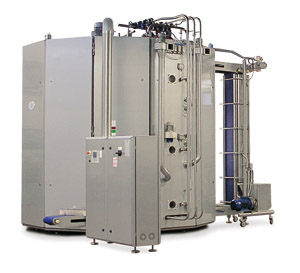Heat treatment tower
22 December 2009Fresh pasta heat treatment equipment is generally comprised of a pasteurization phase performed in a horizontal tunnel within which saturated or superheated steam is injected. Pasteurized products are then off-loaded onto belts or elevators for subsequent drying or cooling phases, also normally performed in a tunnel.
The main drawback to this type of equipment is the significant amount of horizontal space it takes up which is remedied by creating overlapping conveyor belts to provide several parallel runs, or a wider belt that can handle a greater amount of product over the same distance.
The use of overlapping belts which causes the product to rise and fall from one level to another as it moves along, increases the risk of product breakage or deformation, and use of a wider conveyor belt requires a unit at the entrance to the treatment tunnel to correctly distribute the product which, if overlapped, would tend to fuse during pasteurization or high-humidity level phases.
Another problem (but not the last) is the danger of product recontamination following pasteurization, primarily due to contamination from contact with the various conveyor belts or elevators that carry the product through successive treatment phases.
To remedy these problems and to provide a concrete solution for a market that demands the highest level of quality, Essica has expanded its product line to include a heat treatment system with a new construction concept: it works vertically instead of horizontally so that the various treatment phases are stacked and form a heat treatment tower (patent pending) rather than a horizontal line.
In this innovative solution, a single belt runs in spiral motion through all process phases (in ascending order, from pasteurization through drying and cooling), at the conclusion of which the product—already at the correct height—moves on to be weighed and packaged.
This approach is optimal, especially for double-sheet or large-size products; they are placed directly on the belt by the shaping unit and run through all process phases without changing level or being transferred, thus eliminating product overlapping and all those causes of breakage or deformation typical of traditional systems. In addition, the belt, which also undergoes pasteurization as part of the cycle, is basically sterilized, insuring that the final product has a very low residual bacterial count.
Its special dodecagon construction (12 outside doors) and the housing of all mechanical components in the upper part of the unit not only greatly reduce the overall space required, but also allow for rapid access to all treatment areas around the entire perimeter of the unit. This facilitates maintenance and cleaning and the latter is rendered even simpler and quicker by the presence of a built-in continuous belt washing system.
In addition, the reduced volume of the treatment chambers, resulting in a diminution in surface heat dispersal and precise pressurization of the various treatment areas, prevent unwanted heat exchange and result in significant energy savings.
The treatment tower is fully PLC-operated to provide complete control over the entire process and the option of storing and calling-up job files in a rapid, user-friendly way.

